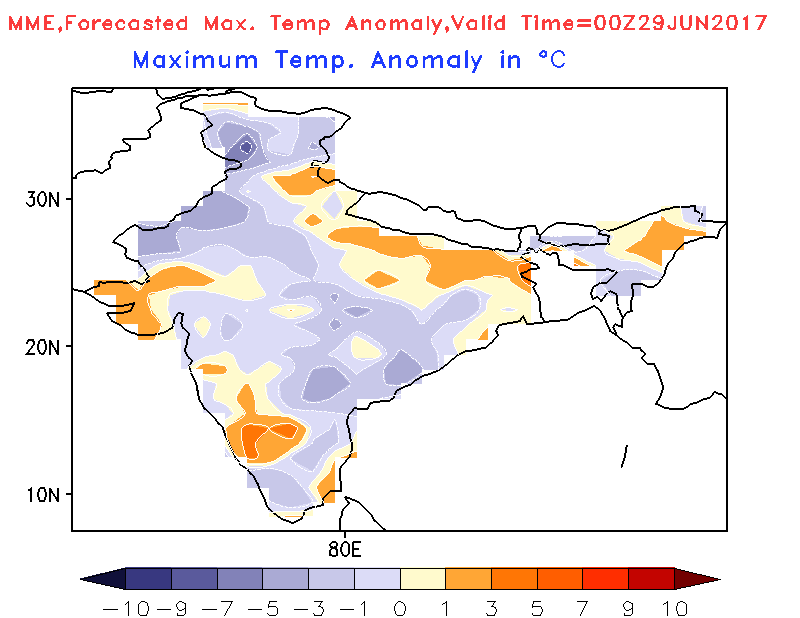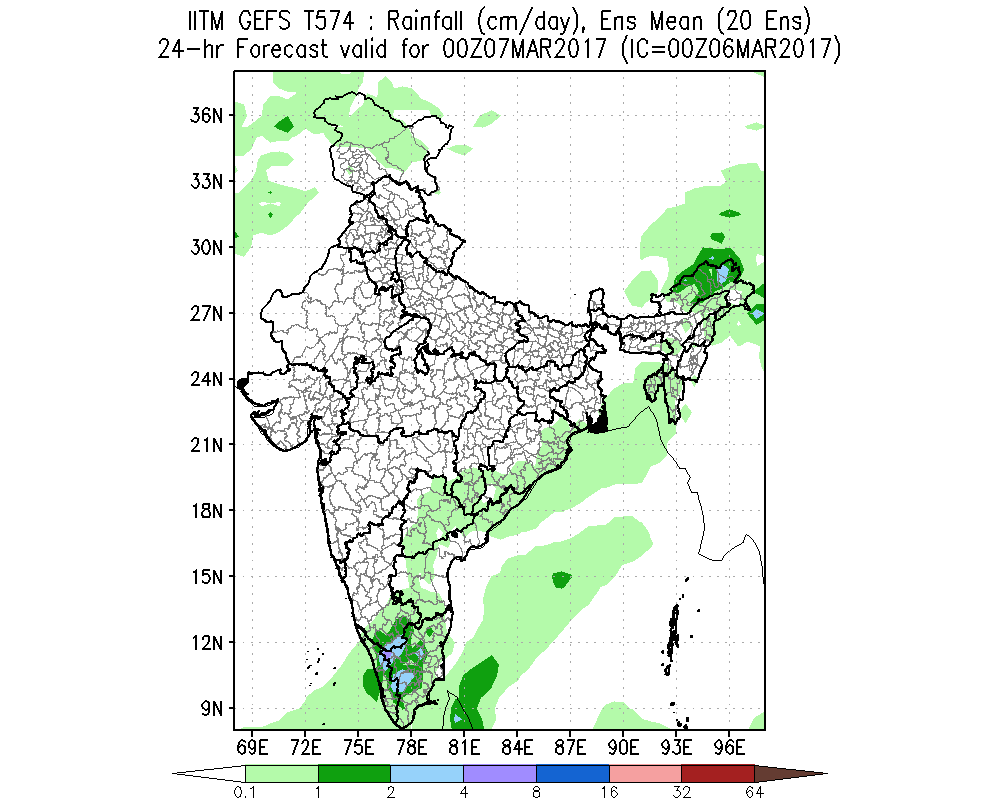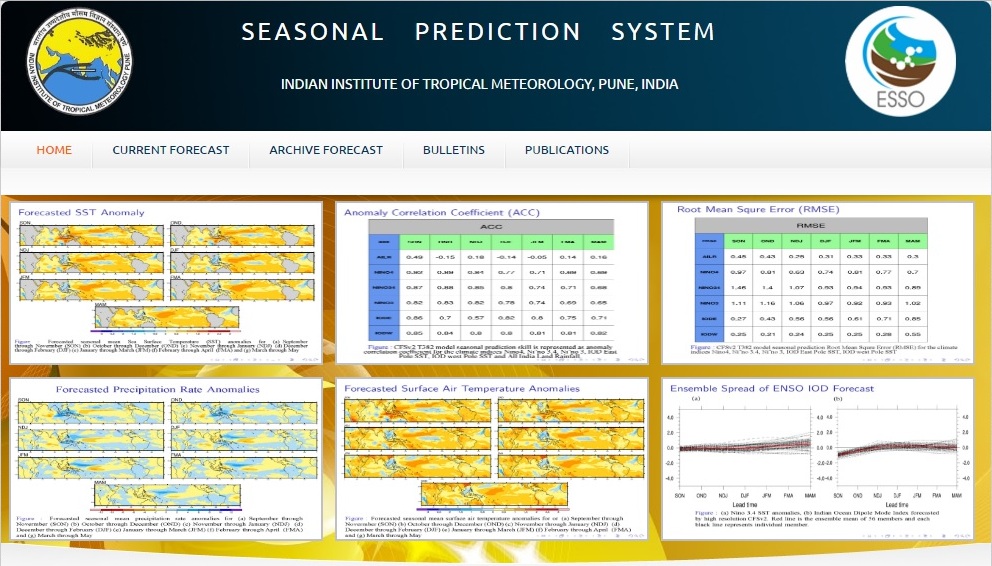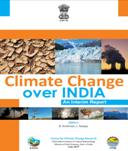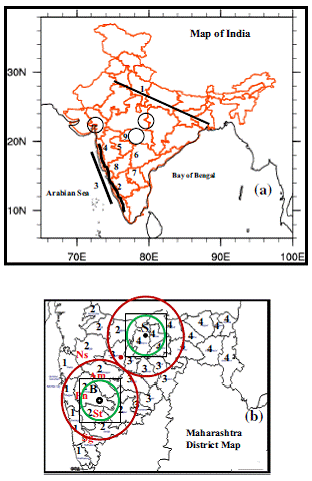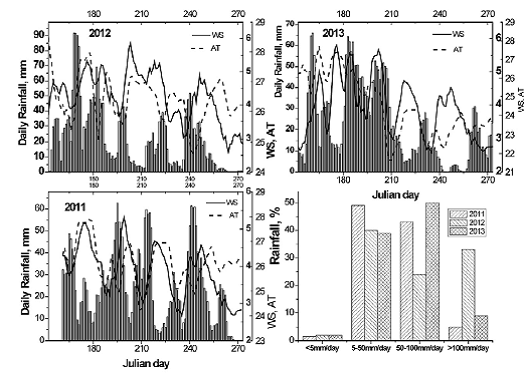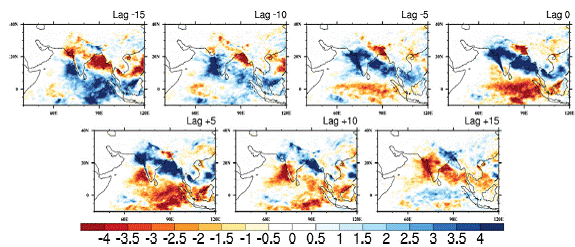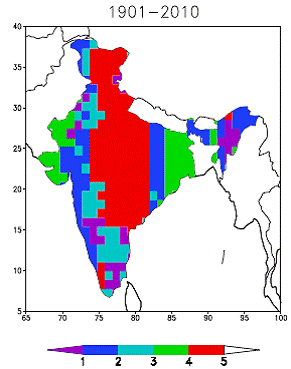IITM Youtube Channel
CLIMATE CHANGE REPORT
IITM Publication Highlights
Statistical analysis of the atmospheric ion concentrations and mobility distributions at a tropical station, Pune
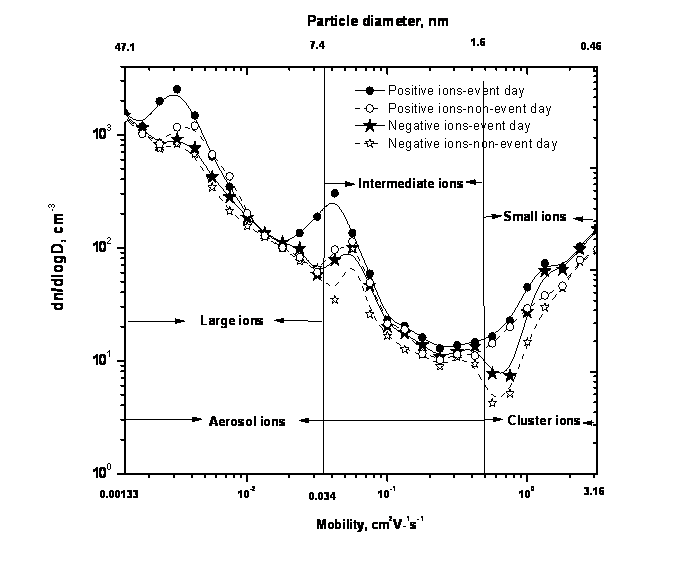 Measurements of ion mobility spectra in the range of 0.00133-3.16 cm2V-1s-1 were made at a tropical station, Pune, India from March 2010 to December, 2012. A total of 12004 hourly averaged ion mobility spectra were obtained over the entire period. The average mobility spectrum shows three distinct peaks for the traditional categories of small, intermediate and large ions. However, to understand the seasonal variability and statistical characteristics of ions that justify their further division into five different categories, we have divided our data in five mobility ranges of small cluster, big cluster, intermediate, light large and heavy large ions. Our results show that small ions in atmospheric conditions at Pune can be further divided into two classes with the boundary at a mobility of 1.78 cm2V-1s-1 (diameter 0.66 nm) where relative standard deviation of ion concentrations starts increasing instead of decreasing with mobility. Some but not all small cluster ions of negative polarity are likely to grow to the intermediate ion size.
Further, the growth from small to big cluster ions is faster for negative than positive ions. In contrast to the observations of the higher mean values of ion concentration in warm season than in winter at a mid-latitude station our observations show higher mean values of ion concentration in winter than in warm season at this tropical station. This contrast in observations at the two sites is explained because to trapping of radioactive emanations by snow at ground during winter at the mid-latitude site.
Our observations indicate that intermediate ions are generated by two independent processes, probably by growth of big cluster ions and by direct nucleation from trace gases. Further, the results indicate that the sources for light and heavy large ions are different.
(Gautam A.S., Siingh D., Kamra A.K., QJRMS, July 2017)
Measurements of ion mobility spectra in the range of 0.00133-3.16 cm2V-1s-1 were made at a tropical station, Pune, India from March 2010 to December, 2012. A total of 12004 hourly averaged ion mobility spectra were obtained over the entire period. The average mobility spectrum shows three distinct peaks for the traditional categories of small, intermediate and large ions. However, to understand the seasonal variability and statistical characteristics of ions that justify their further division into five different categories, we have divided our data in five mobility ranges of small cluster, big cluster, intermediate, light large and heavy large ions. Our results show that small ions in atmospheric conditions at Pune can be further divided into two classes with the boundary at a mobility of 1.78 cm2V-1s-1 (diameter 0.66 nm) where relative standard deviation of ion concentrations starts increasing instead of decreasing with mobility. Some but not all small cluster ions of negative polarity are likely to grow to the intermediate ion size.
Further, the growth from small to big cluster ions is faster for negative than positive ions. In contrast to the observations of the higher mean values of ion concentration in warm season than in winter at a mid-latitude station our observations show higher mean values of ion concentration in winter than in warm season at this tropical station. This contrast in observations at the two sites is explained because to trapping of radioactive emanations by snow at ground during winter at the mid-latitude site.
Our observations indicate that intermediate ions are generated by two independent processes, probably by growth of big cluster ions and by direct nucleation from trace gases. Further, the results indicate that the sources for light and heavy large ions are different.
(Gautam A.S., Siingh D., Kamra A.K., QJRMS, July 2017)
Linkages of subtropical stratospheric intraseasonal intrusions with Indian summer monsoon deficit rainfall
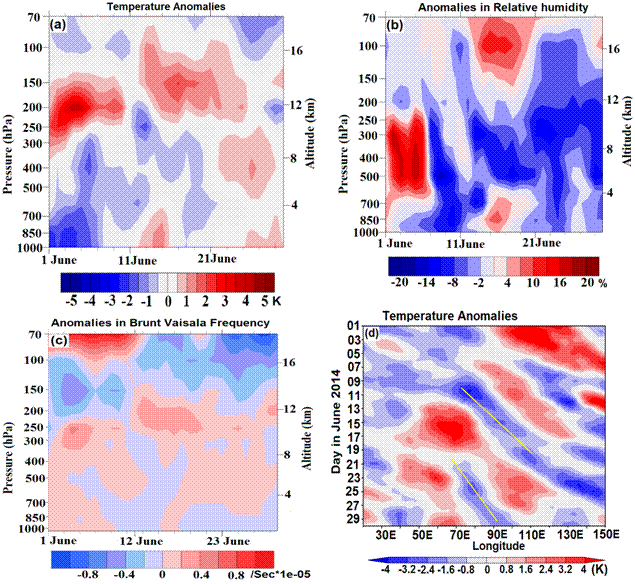 The authors investigate the life cycle of a strong subtropical stratospheric intrusion event and propose a hypothesis through which might reduce the intensity of the Indian-summer-monsoon rainfall (ISMR) after the monsoon onset during June 2014. The diagnostic analysis of ERA-Interim data revealed that stratospheric intrusion occurs in the region of Subtropical Westerly Jet (SWJ) due to Rossby Wave Breaking (RWB). The RWB event is associated with eddy shedding. These eddies transport extratropical stratospheric mass and energy fluxes downward and southward to North India (NI). As a result, the intrusion spread dry, cold and ozone rich air deep into the troposphere (~500hPa) over the NI. It enhances the static stability and weakens the North-South upper tropospheric temperature gradient. The intrusion of cold and dry air persisted for the entire June which might have inhibited northward propagation of ISM convection and could be responsible for prolonged hiatus in northward phase propagation of the ISM after onset. We also investigate the relation between stratospheric intrusion events and ISMR from long term data (1979-2007). Our analysis shows that the stronger negative anomalies of rainfall are associated with stratospheric intrusions during break spells. Thus study reveals that stratospheric intrusion is an important factor that may influence ISMR deficit.
(Fadnavis S., Chattopadhyay R., Journal of Climate, July 2017)
The authors investigate the life cycle of a strong subtropical stratospheric intrusion event and propose a hypothesis through which might reduce the intensity of the Indian-summer-monsoon rainfall (ISMR) after the monsoon onset during June 2014. The diagnostic analysis of ERA-Interim data revealed that stratospheric intrusion occurs in the region of Subtropical Westerly Jet (SWJ) due to Rossby Wave Breaking (RWB). The RWB event is associated with eddy shedding. These eddies transport extratropical stratospheric mass and energy fluxes downward and southward to North India (NI). As a result, the intrusion spread dry, cold and ozone rich air deep into the troposphere (~500hPa) over the NI. It enhances the static stability and weakens the North-South upper tropospheric temperature gradient. The intrusion of cold and dry air persisted for the entire June which might have inhibited northward propagation of ISM convection and could be responsible for prolonged hiatus in northward phase propagation of the ISM after onset. We also investigate the relation between stratospheric intrusion events and ISMR from long term data (1979-2007). Our analysis shows that the stronger negative anomalies of rainfall are associated with stratospheric intrusions during break spells. Thus study reveals that stratospheric intrusion is an important factor that may influence ISMR deficit.
(Fadnavis S., Chattopadhyay R., Journal of Climate, July 2017)
Moisture index during the last two centuries inferred from Western Himalaya tree growth, India
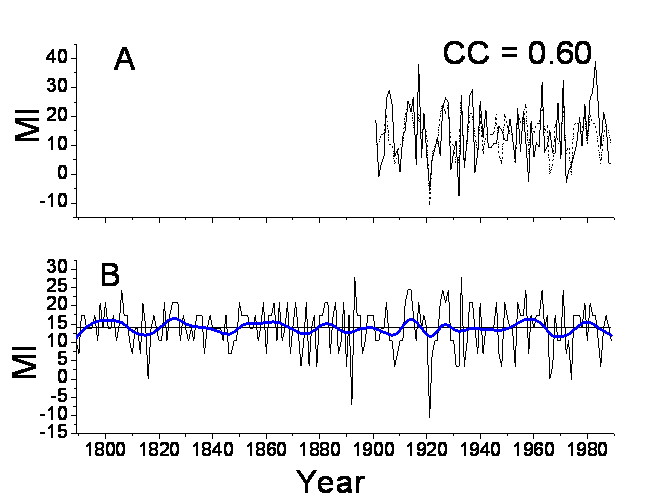 Aregionaltree-ring chronology prepared from two species (Piceasmithiana and Cedrusdeodara) over western Himalaya has been used in relation to climate fluctuations in present study. This analysis shows that moisture index and rainfall during (February to May) have significant positive relationship whereas temperature and heat index showed negative relationship with trees growth. But, moisture and heat index indicate more impact to trees growth than rainfall and temperature. The strong association of tree-rings chronology with moisture demonstrates that tree-rings are much more sensitivity to availability of moisture at trees root zone which enabled us to extend it back to AD 1789; consecutive two years moisture deficiency during 1846-1847, 1908-1909, 1921-1922, 1931-1932, 1947-1948, and 1966-1967 was noticed in the present reconstruction. (Somaru Ram and H.P. Borgaonkar, online June 2017)
Aregionaltree-ring chronology prepared from two species (Piceasmithiana and Cedrusdeodara) over western Himalaya has been used in relation to climate fluctuations in present study. This analysis shows that moisture index and rainfall during (February to May) have significant positive relationship whereas temperature and heat index showed negative relationship with trees growth. But, moisture and heat index indicate more impact to trees growth than rainfall and temperature. The strong association of tree-rings chronology with moisture demonstrates that tree-rings are much more sensitivity to availability of moisture at trees root zone which enabled us to extend it back to AD 1789; consecutive two years moisture deficiency during 1846-1847, 1908-1909, 1921-1922, 1931-1932, 1947-1948, and 1966-1967 was noticed in the present reconstruction. (Somaru Ram and H.P. Borgaonkar, online June 2017)
New Publications
IITM Events
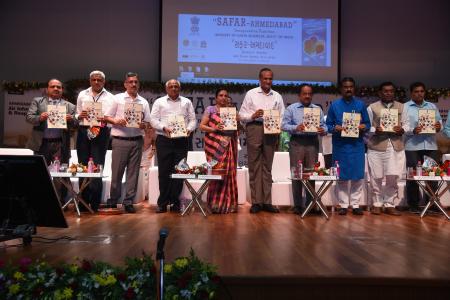
SAFAR-Ahmedabad & Ahmedabad-AIR plan dedicated to the Nation
SAFAR-Ahmedabad an integrated early warning System of Air Quality,Weather and Health was dedicated to the Nation by Dr Harsh Vardhan, Hon'ble Union Minister Science and Technology and Earth Sciences (Govt. of India) along with several State Ministers and dignitaries on 12th May 2017 in Ahmedabad.
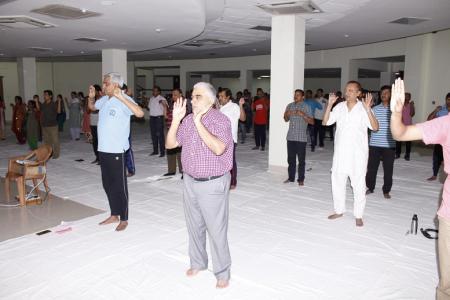
International Yoga Day Celebration at IITM
IITM celebrated the International Yoga Day on 21st June 2017. Mr. Subramanium, volunteer from Isha Foundation conducted the Yoga Session at IITM. Prof. Ravi S. Nanjundiah, Director, IITM inaugurated the session and briefed about the benefits of practicing Yoga. The yoga session was attended by 85 participants.
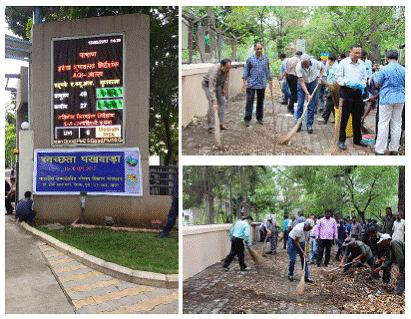
Swachhta Pakhawada Campaign and Tree Plantation at IITM
IITM is observing the Swachhta Pakhawada during 16-30 June 2017. The Swachhta campaign at IITM was inaugurated by Prof. Ravi S. Nanjundiah, Director, IITM. As part of the campaign, all the officials, including the Director took active part in the cleanliness drive. During the campaign, on various days number of cleanliness activities have been carried out by IITM officials, students, recreation club, colony welfare committee, BVG contractual staffs and IITM colony residents.
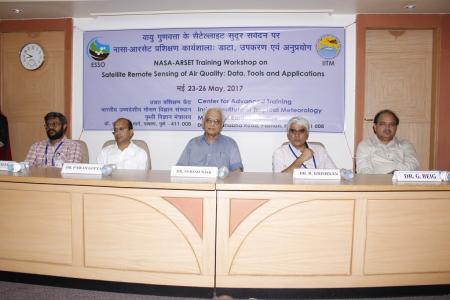
International NASA-ARSET workshop on Remote Sensing 23-26 May 2017
The Institute organized International NASA-ARSET workshop on Remote Sensing of Air Quality: Data, Tools and Applications during 23 - 26 May 2017. The workshop was inaugurated by Chief Guest, Dr. Suresh Naik (Director, Popular Space Science, Chairman, International Space Society, President, Vijnan Bharati, Pune, & Ex-Group Director, ISRO) and Dr. Pawan Gupta (Scientist, NASA-ARSET and Co-ordinator to the Training from NASA).
